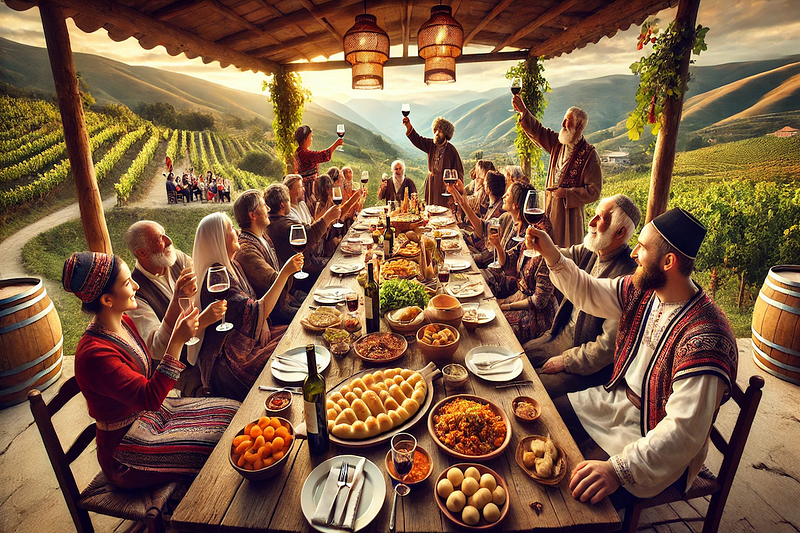Contents
Lost in Translation: The Awkward Greetings That Taught Me the Art of Cultural Connection
From epic toasts to cheeky kisses and firm handshakes, these customs turned awkward moments into lifelong memories and true bonds.
Recently, I wrote an article about how Americans often use “How are you?” more as a casual hello than a genuine inquiry.
Then, it dawned on me: greetings are so much more than polite gestures, they’re a doorway into the soul of a culture.
With that realization, I took a trip back down memory lane, revisiting the many fascinating ways people greet each other in the places I’ve lived, worked and traveled.
Each memory, like a snapshot, shows how connection goes way beyond words.
What I found was nothing short of astonishing.
First Stop, Bonjour! Discover why French greetings had me accidentally kissing a stranger’s ear.
Oui, it happened.
1. France: Kissing on the Cheek, But Make It a Puzzle
On my first trip to a small town in France, I was ready for croissants, cobblestones, and cultural charm.
What I wasn’t ready for was “La Bise”. Introduced to a beautiful young woman by a group of locals I’d just met, I braced myself for what I thought would be a simple cheek kiss.
But wait, was it one kiss? Two? Three? I froze mid-motion, unsure whether to lean left or right.
Spoiler alert: I leaned the wrong way and ended up kissing thin air while everyone laughed kindly at my awkwardness.
Here’s the kicker: the number of kisses varies not only by region but also by time.
Back in the early nineties when I visited, it was fashionable in some places to give three, even four kisses, one for each side, twice over.
And that’s not all. In France, men don’t typically exchange cheek kisses with each other, unless they’re family or very close friends.
I experienced this shift personally over the years.
After visiting the same small town multiple times and staying with a good friend for a couple of months, something changed.
One day, I realized I was kissing just as many men on the cheeks as women.
It was a sign of something deeper, friendships had grown, and I’d gone from being a visitor to being part of the circle.
With every return, the greetings grew warmer, the gestures more familiar.
By then, I wasn’t just awkwardly fumbling my way around with “La Bise”, I was embracing it.
Moral of the story? Brush up on your local kissing etiquette before you go.
And if you’re lucky, you might just find that over time, those gestures of greeting become expressions of belonging.
Ah, vive la France!
Up next: Think a handshake is just a formality? In Ukraine, it’s a test of character.

2. Ukraine: A Handshake That Means Business
When I first started teaching English in Ukraine, one curious ritual immediately caught my attention.
Every time a male student entered the classroom, he would go around and shake the hand of every other male student present.
It didn’t matter if they were teenagers or full grown adults, the gesture was carried out with a seriousness that left me both intrigued and amused.
It was my first glimpse into how deeply ingrained the handshake is in Ukrainian culture.
Over the 20 years I lived in Ukraine, I saw this ritual play out everywhere, from classrooms to business meetings.
A handshake in Ukraine isn’t just a formality, it’s a declaration. I learned this lesson early on when greeting a new local acquaintance.
My handshake, which I thought was firm enough, didn’t quite pass muster.
“Anything less,” he explained with a wry smile, “and people might think you’re insincere.” The grip must be strong, the eye contact steady, and the demeanor serious.
Smiling too much during these first greetings is also uncommon and can be interpreted as overly casual or even disingenuous.
Ukrainians tend to approach first greetings with tinge of stoicism and respect.
But after the formalities are over, whether in a classroom, a meeting, or over a warm bowl of borscht, their genuine warmth quickly comes to the surface.
That’s the beauty of Ukraine: a handshake that commands respect, it means something. It’s also paired with a depth of kindness that makes you feel truly welcome.
Hint: Georgia’s toasting culture will make you rethink greetings altogether.

3. Georgia (The Country): A Toast to Greetings
When I first visited Tbilisi, I thought I understood Georgian hospitality, until a simple handshake and a polite “gamarjoba” turned into a feast.
Within minutes, I was seated at a long table, surrounded by strangers-turned-friends, as plates of khachapuri and hearty stews seemed to appear endlessly.
Then came the toasts, led by the “tamada”, the toastmaster, whose poetic speeches celebrated family, friendship, and guests who were now family.
With every raised glass of wine, and eventually “chacha”, the warmth of Georgian culture became unmistakable.
By the end of the night, I wasn’t just a visitor, I belonged.
Keep reading to discover how Italians turn greetings into an art form.
4. Italy: The Art of the Double Cheek Kiss
When I traveled to northern Italy to research my family tree, I quickly learned that Italian greetings are as diverse as their regional cuisines.
In a small village nestled near the foothills of the Italian Alps, a kind local family who had generously offered to help me track down records explained their customs to me over a light family meal.
“Here in the north,” the father said with a smile, “we’re a little more reserved.
“A handshake is common, even among friends, unless you’re close, then maybe a kiss on each cheek.”
That sentiment was worlds apart from what I’d heard about southern Italy, where greetings are famously exuberant.
There, a double cheek kiss is practically mandatory among friends and family, and even new acquaintances might receive one after a warm introduction.
I couldn’t help but imagine myself flustered in the south, navigating which cheek to kiss first (always the right) and praying I didn’t accidentally headbutt someone in the process.
Even in professional settings, the differences were clear. In the north, a firm handshake suffices.
In the south, however, a handshake might quickly lead to a hearty pat on the back or even a cheek kiss if the meeting turns friendly.
The family I spoke to chuckled at my amazement. “You see,” they said, “our greetings are like our people, different, but all with the same heart.”
Italy truly is a land where even a simple “hello” comes with a story.
Ready for some all-American charm? The USA’s greeting spectrum will keep you guessing.

5. USA: Waves, Handshakes, Fist Bumps and a Whole Lot of “Hey!”
Greetings in the USA are as diverse as the culture itself. From a casual wave or fist bump and “Hey, how’s it going?” to a firm handshake in professional settings, there’s no one-size-fits-all.
A British friend once joked that Americans are “the only people who can make a question a greeting and not expect an answer.”
Believe it or not. After being abroad for over 25 years, I fumble this one too. Like the “fist bump”.
When did people start doing this?
When is this even appropriate?
Flexibility is key when navigating the variety of greetings across the country. Even when it’s your own.
Greetings Speak Louder Than Words
Traveling is about more than seeing new places, it’s about connecting with people, and nothing sets the tone like a greeting.
From cheek kisses to firm stoic handshakes and toasts, each culture offers a unique insight into its values and traditions.
So, next time you travel, pay attention to how people say hello.
It’s the first step toward understanding their world, and maybe even mastering the art of not embarrassing yourself.

David Peluchette is a Premium Ghostwriter/Travel and Tech Enthusiast. When David isn’t writing he enjoys traveling, learning new languages, fitness, hiking and going on long walks (did the 550 mile Camino de Santiago, not once but twice!), cooking, eating, reading and building niche websites with WordPress.


